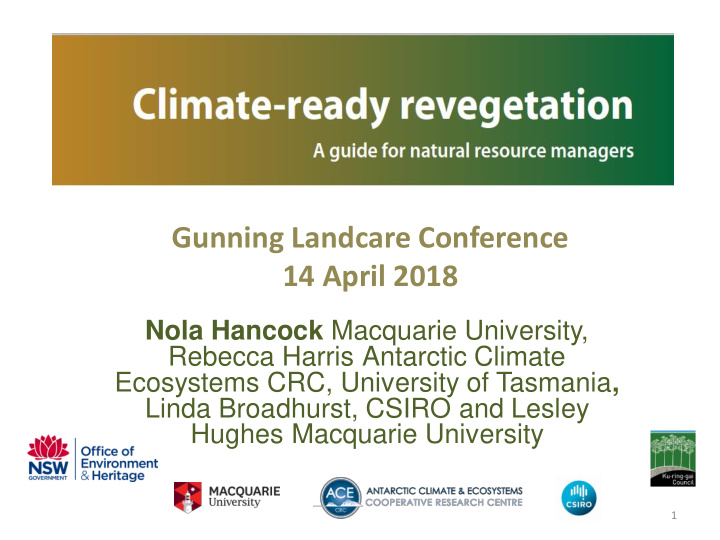



Gunning Landcare Conference 14 April 2018 Nola Hancock Macquarie University, Rebecca Harris Antarctic Climate Ecosystems CRC, University of Tasmania , Linda Broadhurst, CSIRO and Lesley Hughes Macquarie University 1
Farming & native vegetation Native vegetation/revegetation used for: • Agricultural; managing ground water and salinity, erosion control and riverbank stabilization, shelter for stock • Natural resource management / ecology: protecting threatened species, planting corridors for wildlife, multi purpose 2
Climate change is happening now • Uncertainties – future & effects • Temperature • Rainfall • Extreme weather events: frequency / intensity • trends to continue but extent uncertain- e.g. GHG
Uncertainty and vulnerability of species to climate change Species differ in their vulnerability to climate change. Coping mechanisms: • Stay & tolerate or genetically adapt • Move • Locally extinct AND their ability to keep pace with climate change. 4
Uncertainty and vulnerability of species to climate change Generally, those advantaged: • Can tolerate, adapt or move • Keep pace with climate change • Have wide distributions 5
Balance urgency / perfect knowledge Predict iction ion is very diffic fficult ult, , especiall cially y if it is about t the future ure. . Nils Bohr, Nobel Laureate Physics • Models imperfect but consistently show a reduction in species’ distributions • Whole veg communities to disappear • Failed plantings = lost effort time & money 6 Images: The Conservation
Practical decisions now • Continue to revegetate in the manner that we have done in the past? • Plant the same species? • Use the same seed source (local or a different provenance strategy)? • Time of planting? • Change the way we have been doing things? 7
What is the Guide? • Origins • Accessible, useable, available • Online tools (tool box) • Step by step instructions 8
What is the Guide? • Considers climate change only • Does not provide specific recommendations • Booklet and website with downloadable pdf: http://www.anpc.asn.au/resources/climate_ready_revegetation • Updated V2 9
Step 1: What are the climate projections for the site? Step 2: Which plant species will be sustainable for the proposed revegetation site in the future? Step 3: Which provenance strategy will increase the likelihood of the local population surviving in the future? 10
NSW State regions: NARCLiM Near future 2030 (2020 – 2039) & Far future 2070 (2060-2079) vs 1990 -2009 11 http://www.climatechange.environment.nsw.gov.au
Projected changes in av. rainfall Note: 2070 • Directions 2030 • Annual - little change • Seasonal - i.e. spring autumn NARCliM 12
Step 2: Which plant species will be sustainable for the proposed revegetation site in the future? 13
Map the current distribution of the spp. Find location of planting site E. melliodora , site: Albury Yellow Box Reproduced from the Atlas of Living Australia 14
Species’ climate envelope & site location (Gunning) Planting site Reproduced from the Atlas of Living Australia 15
Visualize climate projections to the scatterplot – 3 possible scenarios Best Worst Average (1) Species ok to plant (3) Uncertain (2) At edge 16 Reproduced from the Atlas of Living Australia
ALA or nswnichefinder Blakely’s Red Gum Easy Cleaned data No site located 17
Step 3: Which provenance strategy will increase the likelihood of the local population surviving in the future? 18
Vulnerability to climate change • Wide distributions advantaged but survival of local populations not guaranteed • Other factors e.g. ➢ genetic diversity / inbreeding ) Unknown ➢ adaptive capacity ) • Use Step 2 process 19
Local provenance – traditional practice • Models overstate vulnerability • Traditional practice • Local now no longer local in future • Balance urgency / perfect knowledge • Consider supplementation with non-local provenance(s) Reproduced from the Atlas of Living Australia 20
Provenance strategies: Traditional ‘local’ and new strategies 21 Figure modified from Prober et.al. 2015
Provenance strategies: Local • Seeds sourced within a certain geographical distance to the planting site 22 Figure modified from Prober et.al. 2015
Provenance strategies: Composite • Mix a small % of seed from non-local high quality & genetically diverse populations • Reinstate historical gene flow • Address potential inbreeding & adaption issues Broadhurst et al 2008 23 Figure modified from Prober et.al. 2015
Provenance strategies: Admixture • High uncertainty re scale & rate of change • Source seeds from wide variety of locations • Predicted to build evolutionary resilience Breed et al 2013 24 Figure modified from Prober et.al. 2015
Provenance strategies: Climate-adjusted • Promotes resilience in a changing climate • Seed sourcing biased towards the direction of predicted climate change (but not exclusive) Prober et al 2015 25 Figure modified from Prober et.al. 2015
Provenance strategies: Predictive • Source seeds solely from location experimentally determined to be the best match for the site • Doesn’t allow for gradual shifts Crowe & Parker, 2008 26 Figure modified from Prober et.al. 2015
Strategies for uncertainty Change is occurring and will continue: • Decisions effective under a range of possible future climates • Populations need to be genetically diverse • Identify / rectify constraints & barriers • Manage / reduce existing stressors 27
Thank you Gunning Landcare; NSW Adaptation Research Hub – Biodiversity Node; Ku- ring-gai Council; ANPC; Trevor Booth, CSIRO; Atlas of Living Australia. Images: Andy Burton, Nola Hancock, North Sydney Council Bushcare, Hornsby Community Nursery. 28 Blue Cockatoo. Artist William Burton
Earlier & Altered community longer pairing Earlier composition in freshwater in sleepy emergence macroinvertebrates lizards in butterflies Some species are Reduced Earlier arrival of responding in situ body size in migratory birds passerines Increased growth rates
BUT SOME ARE NOT south west of Western Australia, forest spp dying / changing 2017 heatwave kills ~45,500 flying foxes Bramble Cay Melomys s.e. Qld Coral reef bleaching GBR 6% of the Gulf of Carpentaria mangrove forest died 2015-16 WA kelp forests before & after dieback 2011 Images: The Conservation 30
Recommend
More recommend